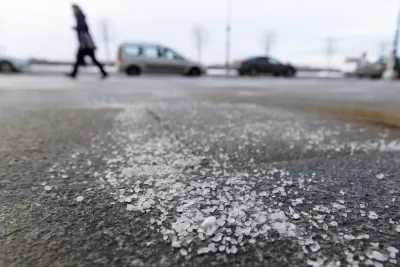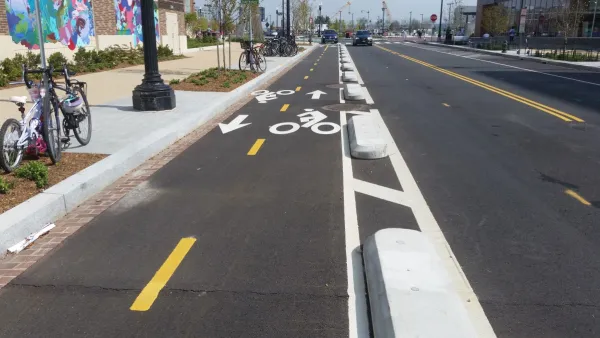Winter-oriented road design can limit the amount of polluting chloride used on the state’s roads to mitigate winter conditions.

A new road design movement in Minnesota aims to change the way we build roads and sidewalks to minimize the need for road salt, which can improve winter road conditions but also pollutes nearby water bodies with chloride. “Road salt damages vehicles, pavement and bridges, and it costs state and local governments.”
As Kirsti Marohn explains in an article for MPR News, “Low-salt design is the brainchild of Connie Fortin, a salt reduction expert who's trained more than 20,000 snowplow drivers and property maintenance workers over more than two decades.”
Developing road designs that account for where snow will pile up can reduce the need for road salt and speed up ‘pavement recovery’ without salt. For example, “Planting deciduous trees instead of coniferous along the south side of a sidewalk can reduce shadows. Designing a building so its parking lot gets full sun helps melt snow and ice quicker.”
According to Marohn, “While the design principles are voluntary right now, there’s a possibility they could become future requirements, as cities struggle to meet limits on the amount of chloride in the stormwater they are permitted to discharge into lakes and rivers.”
FULL STORY: How rethinking design could reduce the need for road salt

Planetizen Federal Action Tracker
A weekly monitor of how Trump’s orders and actions are impacting planners and planning in America.

Congressman Proposes Bill to Rename DC Metro “Trump Train”
The Make Autorail Great Again Act would withhold federal funding to the system until the Washington Metropolitan Area Transit Authority (WMATA), rebrands as the Washington Metropolitan Authority for Greater Access (WMAGA).

The Simple Legislative Tool Transforming Vacant Downtowns
In California, Michigan and Georgia, an easy win is bringing dollars — and delight — back to city centers.

The States Losing Rural Delivery Rooms at an Alarming Pace
In some states, as few as 9% of rural hospitals still deliver babies. As a result, rising pre-term births, no adequate pre-term care and "harrowing" close calls are a growing reality.

The Small South Asian Republic Going all in on EVs
Thanks to one simple policy change less than five years ago, 65% of new cars in this Himalayan country are now electric.

DC Backpedals on Bike Lane Protection, Swaps Barriers for Paint
Citing aesthetic concerns, the city is removing the concrete barriers and flexposts that once separated Arizona Avenue cyclists from motor vehicles.
Urban Design for Planners 1: Software Tools
This six-course series explores essential urban design concepts using open source software and equips planners with the tools they need to participate fully in the urban design process.
Planning for Universal Design
Learn the tools for implementing Universal Design in planning regulations.
Smith Gee Studio
City of Charlotte
City of Camden Redevelopment Agency
City of Astoria
Transportation Research & Education Center (TREC) at Portland State University
US High Speed Rail Association
City of Camden Redevelopment Agency
Municipality of Princeton (NJ)





























